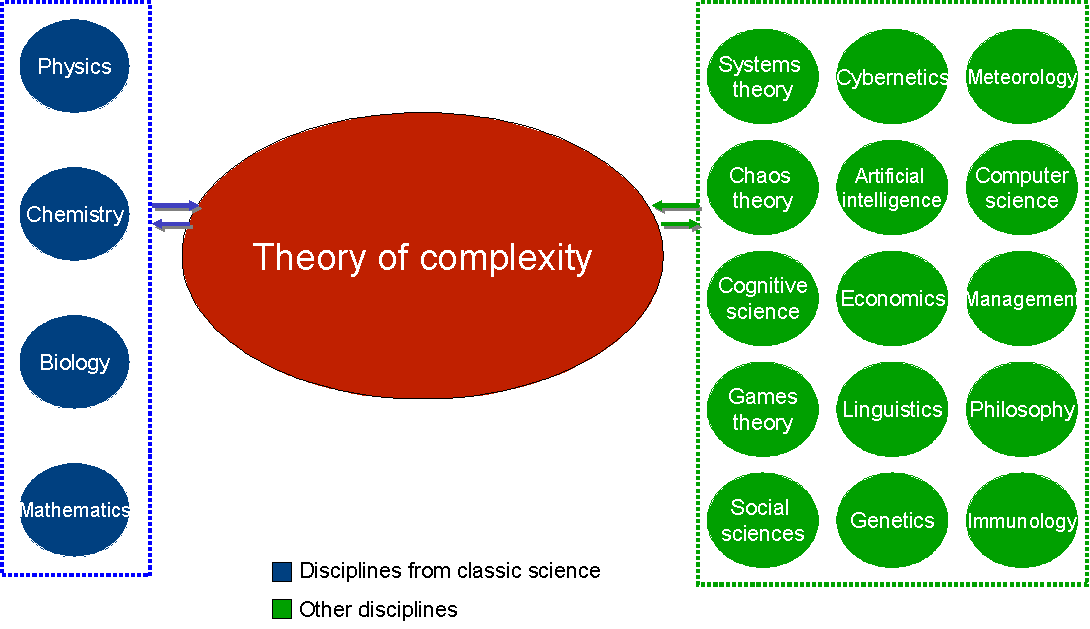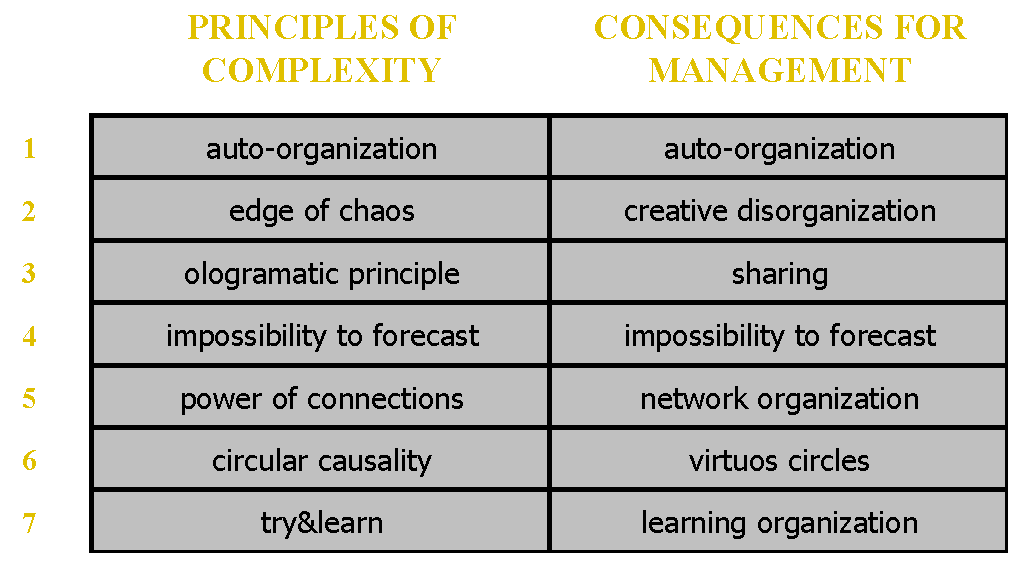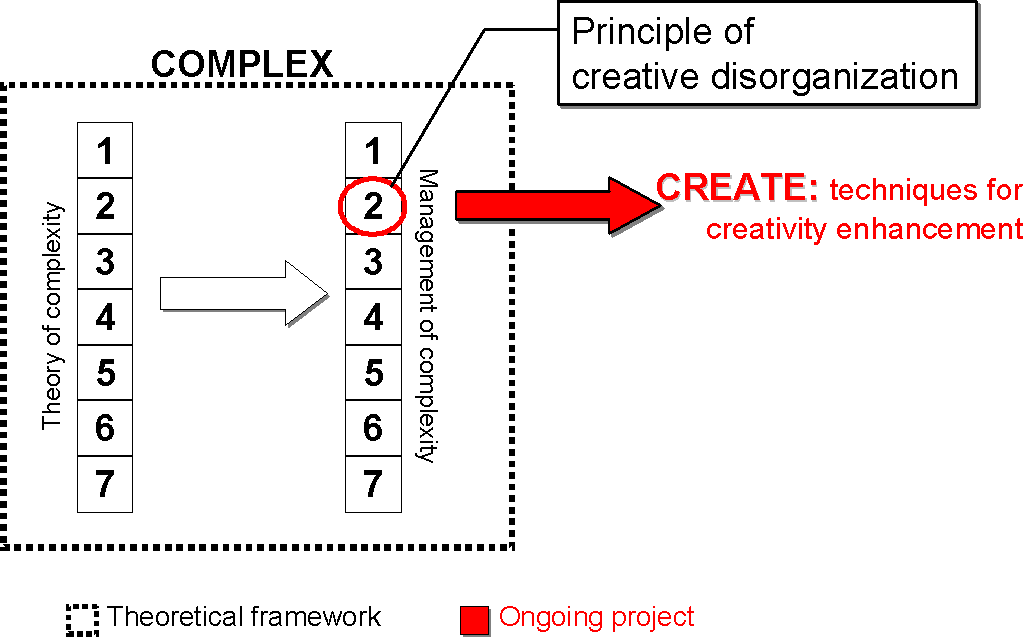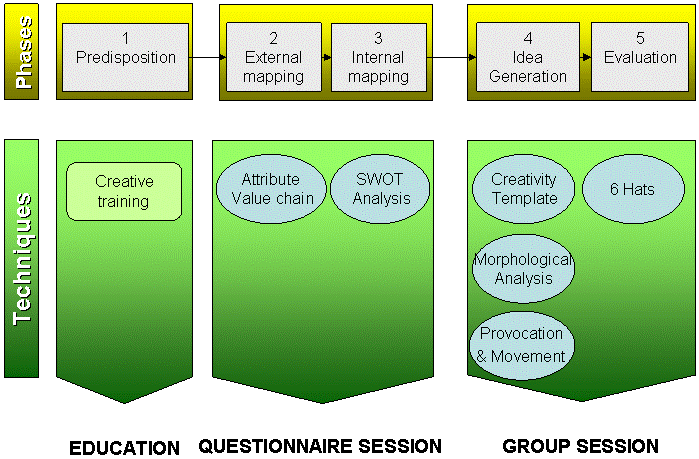The research about creativity inside firms that University of Udine is doing took origin from the studies about theory of complexity. We found out that creativity is an emergent complex phenomenon and we understood its importance for animals, human beings and firms too. Theory of complexity studies complex adaptive systems: what are they?
COMPLEX ADAPTIVE SYSTEMS (CAS)
Theory of complexity is a multidisciplinary science (Morin, 1990; De Angelis, 1996; Battram, 1999): it takes into consideration elements of very different disciplines, such as systems theory, cybernetics, meteorology, chaos theory, artificial intelligence (A.I.), artificial life, cognitive sciences, computer science, ecology, economy, evolution studies, genetics, games theory, immunology, linguistics, philosophy, social sciences, management (fig.1).

Fig.1 - Theory of complexity as a multidisciplinary science.
Complex systems are characterized by numerous and different elements and numerous and non-linear connections; moreover CAS, which are complex living systems, are characterized by capacity of adaptation (Holland, 2002). A CAS may be therefore described as an aggregate of agents and connections, organized to grant adaptation: according to Holland (1995), a CAS is a system that emerges over time into a coherent form, and adapts and organizes itself without any singular entity deliberately managing or controlling it.
This capacity of adaptation is reached through elaboration of information and model building (Cerrato, 1996): the most important aim for the elements of the system is adaptation and to reach their aim they continuously look for new ways to do things and to learn. Thus, they create extremely dynamic systems, where small changes can generate unimaginable consequences (Axelrod and Cohen, 1999), that is, butterfly effect. They place themselves between simplicity - too close to the immobility of a mechanism - and uncheckability - too close to loss of control (Battram, 1999).
PRINCIPLES OF THEORY OF COMPLEXITY AND CREATE PROJECT
Since theory of complexity is a multidisciplinary science, literary contributions are numerous and heterogeneous. Therefore, we tried to rationalize this huge field by identifying seven principles of theory of complexity and seven consequent principles for firms (fig.2; source: De Toni and Comello, 2004), that can be considered complex adaptive systems too.

Fig.2 - Principles of theory of complexity and management of complexity (De Toni and Comello, 2004).
For CREATE project we focused on the important principle of management of complexity about creative disorganization. Therefore, we tried to find out the most important techniques that can enhance creativity inside firms (fig.3).

Fig.3 - From the principles of theory of complexity to CREATE project.
THE EDGE OF CHAOS
The principle of theory of complexity that underlines the importance of creativity for every complex adaptive system is the one about the edge of chaos. Evolution takes CAS to that area between order and disorder called by complexity scholars edge of chaos (Waldrop, 1992). It is the only place where life can take place. Too much order causes death by ossification, too much disorder causes death by disintegration. According to Cohen (1997, p.69): "At the edge of chaos, the borders of change continuously flow between a stagnant status quo and the anarchy of endless destruction". Thus, edge of chaos is a dangerous place to be visited. It isn't order nor disorder. It is between order and disorder. It is a place of creation, but it can be even a place of destruction.
This principle invites us to accept the contemporary presence of contrasting concepts (Morin, 1990), such as order and disorder, creation and destruction, life and death. We should move from "or" culture to "and" culture (Amietta, 1991): things don't exclude themselves, annul each other, neutralize, but coexist, sum themselves, live together, integrate, recall, find a dynamic equilibrium between them. Moreover, we should accept disorder as necessary for creation (Morin, 1990). Disorder is everywhere (Bohm, 1957): in all living systems (Morin, 1990), in our mind (De Angelis, 1996), in every organization (Quattrocchi, 1984), in history (Waldrop, 1992).
THE CREATIVE DISORGANIZATION
The edge of chaos is reached by firms through creative disorganization, a principle similar to the concept of innovation proposed by Austrian economist Schumpeter (1942), who defined "the agglomerates of explosion" generating change as "perpetual storms of creative destruction". In CAS, and therefore in organizations too, when a higher degree of autonomy is given to agents to make decisions locally, outcomes are then allowed to emerge in a deviation-amplifying way or through positive feedback (Dooley and Van de Ven, 1999). Many of the creative activities found in firms emerge in this fashion. Thus, it is necessary to forget the idea that success comes from stability and order: life and innovation are generated at the edge of chaos (fig.4) - between formal and informal structures (Pascale, 1990; Stacey, 1991, 1992). Dee Hock, one of the founder members of VISA, calls his organization "chaord organization", where chaord points out the right mix between chaos and order (Savage, 1996).

Fig.4 - The edge of chaos between order and disorder (De Toni and Comello, 2004).
Creative disorganization can be facilitated acting in three different directions: organizational structures, directional styles, and management.
Looking at organizational structures, it is necessary to create flat structure (Peters, 1992; Savage, 1996), lateral roles of co-ordination (Foster and Kaplan, 2001) and decisional decentralization (Pascale, 1992; Peters, 1992).
Looking at directional styles, it is necessary to develop intrapreneuring (Peters, 1992; Keene, 2000), not to fear mistakes (Pascale, 1992; Peters, 1992; Foster and Kaplan, 2001) and not to fear conflicts, but exploit them (Pascale, 1992; Ciappei and Poggi, 1997; Olson and Eoyang, 2001).
Looking at management, it is important to use techniques to develop single and group creativity (Peters, 1992; Foster and Kaplan, 2001).
The capabilities which serve the innovative process are located within the supplier, within the purchaser, and emerge as a consequence of the interactions between the two parties. Therefore, there is necessity to adopt creative techniques for collaborative new product development. In particular we suggest a methodology that is articulated into five steps to generate collaboration and new ideas: external and internal mapping, predisposition, creative process and evaluation (fig.5).

Fig.5 - Phases and techniques for creativity enhancement in firms (De Toni, Sanfilippo and Comello, 2004).
Predisposition is concerned with creating an internal environment that may favour new ideas and rapidly eliminate old-fashioned ones. We think that a preventive creative training can be very useful to make people comfortable with such an argument and in particular with some basic techniques and procedures.
Regarding external mapping, enterprises select external stimuli interpreting them according to their knowledge. In order to collect external signals, it is essential for organizations to take part to exhibitions and meetings, to get in touch with suppliers and develop interesting ideas about the relationship between them and the enterprise itself. An important technique is the attributes-value chain one.
Internal mapping is concerned with valuing the inner cognitive capital in order to exploit its potential and aid new business ideas to rise up. A technique that can be used for internal mapping is SWOT analysis. This technique may be used both to search not yet evident internal problems and to point out some new focus.
Creative process is the idea generation. In this phase it can be very useful to involve suppliers in order to realize a sort of "cross fertilization" (Koestler, 1975) and produce new ideas.
Evaluation consists in the selection of the best ideas according to the inner judgment criteria of the enterprise. The technique we suggest for this phase is six thinking hats, invented by De Bono (1992). It allows to divide logic from emotions, creativity from information, idea generation from idea evaluation, and to consider ideas from different points of view.